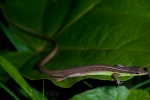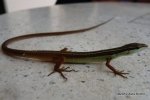Takydromus sexlineatus

|
|
|
|
English name: Long-tailed Grass Lizard (aka “Asian Grass Lizard”)
Scientific name: Takydromus sexlineatus
Thai name: Ging-ga-noi Hang Yao or Ngu Ka
Description: To 36 cm long. Snout to base of tail is up to 8 cm. A small slender lizard with an extraordinarily long tail. Body is brown with cream line on each side. Sides are darker than the top of body and have scattered cream speckles. Front lower part of body is usually greenish, fading towards light brown by the back legs. Head is distinct but narrow and has the same color pattern as the body. The original tail can be incredibly long, more than three times as long as the body, and is light brown. Underbelly is pale.
Similar Species: Oriental Garden Lizard has a larger head, a body that is higher than it is wide, very rough scales, often a dorsal crest, and lacks the green coloration on the sides.
Habitat: This lizard normally lives in grasslands but can sometimes be found in forest clearings, forest edges, shrubland, and agricultural land. Usually found in tall grass, which it often climbs.
Place in the ecosystem: Eats insects. Eaten by snakes and birds.
Danger to humans: Though it may attempt to bite when handled, this lizard is far too small to be dangerous to humans.
Conservation status and threats: Is a widespread species that can tolerate some human modifications of its environment. Though it is collected for the pet trade and as a food source for captive Chinese birds, the impacts on its populations are thought to be minimal. No known conservation issues.
Interesting facts: The long tail of the Long-tailed Grass Lizard is an adaptation to its grassland habitat. Being able to climb to the tops of grass stalks is an advantage in the grasslands because it allows a lizard to reach the full strength of the sun to bask, as well as putting it out of the reach of some predators and putting more insects within its reach. A long slender tail gives the Long-tailed Grass Lizard more points of contact as it climbs though the grass stalks without significantly adding to its weight, thereby improving its support and balance amongst these narrow, lightweight stalks. The skinks that share its grassland habitat do not have the same lightweight body and extremely long tail, and thus are restricted to finding sunlight in clearings and hunting insects on the ground. The long tail also distributes the lizard’s weight more effectively when it jumps from grass stalk to grass stalk, thereby enabling it to quickly and efficiently move through the grass and flee from predators.
I know of no records of Long-tailed Grass Lizards in the Bangkok area. However, they are found in adjacent parts of Thailand and it is possible that they could be found in Bangkok in the right habitat.
References:
Hong Kong University: Takydromus sexlineatus ocellatus
IUCN Red List: Takydromus sexlineatus
Wikipedia: Takydromus sexlineatus
Michael Cota, personal communication.
A Photographic Guide to Snakes and Other Reptiles of Peninsular Malaysia, Singapore and Thailand
A Field Guide to the Reptiles of South-East Asia
Hong Kong Amphibians and Reptiles (2nd Edition)
The Lizards of Thailand
Simon and Schuster’s Guide to Reptiles and Amphibians of the World









I live out in Minburi area. I’ve seen quite a few species even though we’re still in populated area. Saw what I think may have been a Long-tailed Grass Lizard. It was mid-day, along our rock clad planter. It did not stay long enough for me to get a good enough look. It had bright yellowish stripe but I didn’t get a good enough look. It was fairly long compared to other lizards and skinks I’ve seen around here. I’d say lose to 25 cm. We’re not that far from klong and some marshy type habitat. Any other suggestions what it might have been?
There’s a good chance that it could have been an Oriental Garden Lizard. Young ones are very slender and can have a yellowish stripe. It would be good to get a better look – I’d be excited if you saw a Long-tailed Grass Lizard, since I’m not sure where in Bangkok they would still be found.
See the following picture for an example of a very young Oriental Garden Lizard:
Well, it was darker except for the stripe. Although I saw one similar to that in a palm tree of ours. He was I think preying on the small bees that gather in the AM around flowering.
I’m actually pretty surprised and fortunate at the diversity of skink, lizard and snakes around property. One pretty fast tree snake, and couple of others.